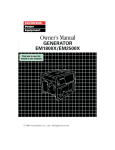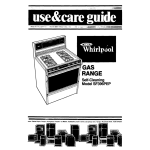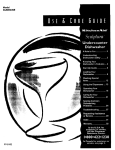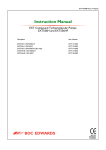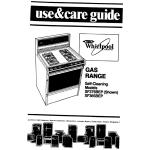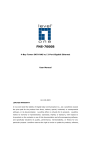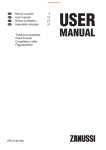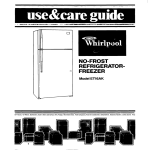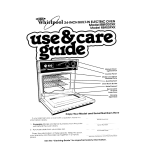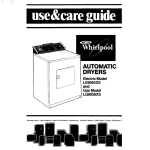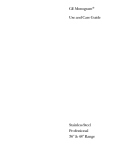Download Chrysler 2007 Town and Country Automobile User Manual
Transcript
KitchenAid" Kltchen_kld" No-Frost Refrigerator Models KSRS22Q KSRB22Q KSHS22Q KSPB22Q A Note toYou KSPS22Q KSRS25Q KSRB25Q ...................... 2 Impodonl Sofety Instructions ........................... 3 Paris ond Feolures ............... 4 Installing lhe Refdgerotor ..... 5 Using the Refrigerotor ........... 7 Codng for the Re_gerotor ........................ 21 Food Sloroge Guide .......... 24 If You Need Assidcr_ce or Service .......................... 26 wam:z_ ............................2s Call UsWith Questions Or Comments: 1-800-422-1230 Use and Care Guide .,q Note to You Thank you for buying a KitchenAicl ° home appliance. You have purchased a quality, world-classhome appliance, Years of engineering experience went Into Itsmanufacturing. To ensure that you enjoy many years of trouble-flee operation, we developed thisUse and Care Guide. It Isfullof valuable information on how to operate and maintain your home appliance properly and safely. Please read It carefully. Also, please complete and mall the Ownership RegistrationCard provided with your home appliance. Your safety is important to us. This guide contains safety symbolsand statements. Please pay special attention to these symbols and follow any Instructions given. Here is a brief explanation of the use of each symbol. Thissymbol wUlhelp you avoid actions which could cause product damage (scratches, dents, etc.) and damage to your personal property. Thissymbol _11 help alert you to such dangers as personal Injury, burns, fire and electrical shock. Our Consumer Assistance Center telephone is toll-free, 24 hours a day. number, 1-800-422-1230, If you ever have a question concerning your home appliance's operation, or If you need service, feel free to call our toll-flee Consumer Assistance Center telephone number for help. When calling, you will need to know your appllance°s complete model number and serial number. You can find this Information on the model and serial number label (see diagram on page 4). Foryour convenience, we have Included a handy place below for you to record these numbers. Also, please record the date the product was purchased/Installed and the Builder's or Dealer's name, address and phone number. You will need this Information If you ever require service. Keep this book and the sales slip together In a safe place for future reference. IMPORTANT:You must provide proof of purchase or Installation date for In-warranty service. Model Number Builder/Dealer Name Serial Number Address Date Purchased Phone Don't forget, KitchenAld offers a full line of quality home appllances. Built-In RefTIgerators TrashCompactors Ranges & Cooktops Freestanding Refrigerators Hot Water Dispensers Microwave Ovens 50-Pound Ice Makers Food Waste Disposers Washers & Dryers Dishwashers Built-In Ovens Mixers & Blenders Formore Information on these appliances, or the one you have purchased, call our toll-flee Consumer Assistance Center telephone number, 1-800-422-1230. 2 Important Safety Instructions To r_3=_:cethe risk of fire, e'.: :_ical shock, or Injury when ,__=!ng the refrigerator, follow .'-=-_-_=!c procautlons Including the following: • Read all Instructions before using the refrigerator. • Child entrapment and suffocations are not problems of the past. Junked or abandoned refrigerators are still dangerous.., even If they will 'just sitIn the garage for a few days." If you are getting rid of your old refrigerator, do It safely. Please read the enclosed safety booklet from the Association of Home Appliance Manufacturers. Help prevent accidents. • Never allow children to operate, play with or crawl inside the refrigerator. • Never clean refrigerator parts with flammable fluids. The fumes can create a fire hazard or explosion. • FORYOUR SAFETY• DO NOT STORE OR USE GASOLINE OR OTHER FLAMMABLE VAPORS AND LIQUIDS IN THE VICINITY OF THIS OR ANY OTHER APPLIANCE. THE FUMES CAN CREATE A FIRE HAZARD OR EXPLOSION. - SAVE THESE INSTRUCTIONS - Help us help you Please: • Install and level unit on a floor that will hold the weight, and in an area suitable for Its size and use. • Connect only to the proper kind of outlet, with the correct electrical supply and grounding. (Refer to the Electrical Requirements and Grounding Instructions Sheet.) • Use unit only for the uses described In this manual. • Make sure unit Is not near an oven, radiator or other heat source. • Properly maintain unit. • Make sure unit Is used In an area where the room temperature will not fall below 55°F (13°C). • Make sure unit Is not used by anyone unable to operate It properly. • Make sure unit Is not loaded with food before It has time to get properly cold. 3 Parts and Features Thissection contains captioned Illustrations of your appliance. Use them to become familiar wilh where all pads and features are located and what 1hey look like. Ught Control panel Ught I Utilitybucket i Model and serial number label (on side wall) _aiw n compartment dispensers (number varles with model) Automatic Ice bln IIIII Ught n_ s,.,onaIll Wine/egg rack IIIII _.,u.a_,° IlUl freezer shelf I,,_ Slide-out freezer IIHI ,.elves Ught Crisper cover Crisper with humldlty control II. Stationary door shelves deaf locker Base grllle Meat locker temperature control (on side wall) Defrostpan (behind base grllle) Adjustable door blns with bln glldes Model KSRS25Qshown Control Panel Kl,llehomUllJId -- Freezer _ 1_. oold ._ 1 2 _ 34 -- Rolfl_lorotor q-- (:older i Freezer control 1 2 1 3 4 / Refrigerator control O Installing the Refrigerator In This Section Page Page Cleaning the refrigerator .......................... 5 Plugging In the refrigerator ....................... 5 Locatlng the refrigerator properly ............ 6 Leveling the refrigerator ............................ 6 i I If you want your refrigerator to work properly, you need all you need to know to Install your refrigerator. Cleaning to Install It properly. This section tells you the refrigerator Clean your refrigerator before using It, If necessay/. See cleaning InstTuctlons on pages 21 and 22. Remove the Consumer Buy Guide Label and any shipping tape before using the refrigerator. IMPORTANT:DO NOT USEsharp Instruments, rubbing alcohol, flammable fluids or abrasive cleaners. These can damage the material. See "important Safety Instructions" on page 3. DO NOT REMOVEthe Tech Sheet fastened under the refrigerator, behind the base grille. To remove any remaining glue: • Rub briskly with your thumb to make a ball, then remove. OR • Soak area with liquid dishwashing detergent before removing glue as described above. Plugging 3-prong grounding type wall receptacle in the refrigerator A 115 Volt, 60 Hz., AC only, 15 or 20 amp fused and properly grounded electrical supply is required. It Is recommended that a separate circuit, serving only this appliance, be provided. Do not use an extension cord. Use a receptacle which cannot be turned off with a switch or pull chain. See Elecffical Requirements and Grounding Instructions Sheet In your Literature Package. 3-prong grounding i Power core Recommended grounding method 5 Locating the refrigerator properly 1. Allow 1/2Inch (1.25 cm) on each side of the refrigerator for ease of Installation. 2. The refrigerator back can be flush against the wall. 3. If _ refrigerator Isto be against a wall, you mlght want to leave ex_a space on the hinge side closest to the wall so the door can be opened wider. Leveling the refrigerator Your refrigerator has 2 front leveling rollersone on the left and one on the right. To adjust one or both of these, follow the directions below. 1. Remove the base grille. (See page 18.) 2. To raise front, turn screw clockwise. 3. To lower front, turn screw counterclockwise. 4. Check with level. 5. Replace base grille. (See page 18.) Right to raise; left to lower Leveling screw Raise Usescrewdrlver to adjust 6 Lowor Using the Refrigerator In This Section Page Page Setting the controls ................................... 7 Removing the freezer shelf ..................... 13 Changlng the control settings .................. 8 Removing the freezer baskets ............... 13 Removing the refrlgeratot door blns .......8 Uslngthe Ice maker ................................ 13 Adjusting the bin glldes ............................ 9 Removing the ice maker storage bln ............................................... 14 Removing the can dispensers .................9 Adjusting the cantilever refrlgerator shelves ................................... 9 AdJustlngthe RollerTracTM shelf ............. 10 Uslngthe wlne/egg rack ........................ 10 Removing the crispers and cover ......... 11 Usingthe cold water and ice dispensers ................................................ 15 Removing the base grille ....................... 18 Removing the defrost pan ...................... 18 Changlng the light bulbs ........................ 19 Removing the meat locker .................... 11 Understandlng the sounds you may hear .................................................. 20 Adjusting the meat locker temperature control ................................ 12 Saving energy ......................................... 20 Removing the freezer door shelf fronts ................................................ 12 To obtain the best possible results from your refrigerator, It IsImportant Jhat you operate It properly. ThIssection tells you how to do just that. Setting the controls Controls for the refrigerator and freezer are In the refrigerator, When the refrigerator Isfirst plugged In: I. Set the Refrigerator Control to • (between numbers 2 and 3). Refrigerator II 2. Set the Freezer Control to • (between numbers 2 and 3). 3. Glve the refrigerator time to cool down completely before adding food. Thismay take several hours. The settingsindicated al:x)ve should be correct for normal, household refrigerator usage. The controls are set correctly when milk or julce Isas cold as you like and when Ice cream isfirm. If you need to adjust these seHJngs,see "Changing the control settings" on page 8. IMPORTANT:The Automatic ExteriorMoIsture Control continuously guards against moIsture buildup on the outside of the refrigerator cabinet. This control does not have to be set or adjusted. off I 2 - 3 4 colder Freezer cold I 2 - 3 4 colder Changing the control settings To change the temperature settings, follow the steps below: 1. Adjust the Refrigerator Control first. 2, Walt at least 24 hours before making further adjustments. Thisglves the refrigerator and/or freezer time to reach the set temperature. 3. Adjust the Freezer Control If necessary. To make the refrlgerator or freezer colder, slide the control toward the number 4 setting. To make the refrigerator or freezer lesscold, slide the control toward the number I setting. Changing elther the Refrigerator Control or the Freezer ConJTolwill affect the temperatures of both compartments. Use the settingslisted In the chart below as a guideline when adjusting the temperature controls. The following reasons can cause the conditions listed below: • Door opened often • Large amount of food added • Room temperature too warm * Room temperature too cold (Refrigerator can't cycle often enough.) • Controls not set correctly for your conditions • Heavy Ice usage RECOMMENDEDCONTROLSETTINGADJUSTMENTS: Refrlgerator Freezer CONDITION: Refrigerator section Istoo warm 3 2 Freezer section Is too warm 3 3 Refrigerator section Istoo cold 3 3 Ice Isn't made fast enough 3 3 Both sections are too warm 3 3 Removing the refrigerator To remove bins: I. LJftbln up. 2. Pullbln straight out. To replace bins: I. Hold back of bin above desired bin guide. 2. Push bin back and down until It stops. door bins Adjusting the bin glides Use the bln glldesto secure odd-shaped Items Inthe door blnsor to separate other Items. To adjust lhe glides: I. Grasp gllde. 2. Move glide along bln. Removing the can dispensers Each dispenser holds 5 beverage cans In a convenient place, leaving more shelf space for larger Items. To remove dlslpenser: I. Uft dlspenser up. 2. Pull dlspenser stralght out. To replace dispenser: I. Hold back of dispenserabove desired guide. 2. Pushdispenser back and down until It stops. IMPORTANT:When replacing the can dispensers, you must replace the boffom dispenser first. Adjusting the cantilever Adjust the shelves to match your refrigerator. To remove the way you use shelves: I. Tilt shelf up at front. 2. Uft shelf up at back. 3. Pull shelf straight out. IMPORTANT: Glass shelves are heavy, with care. Handle To replace shelves: I. Guide the rear hooks of shelf Into slots In the shelf supports. 2. Tilt shelf up at front until hooks drop Into slots. Lower front of shelf to level position. 3. Check the stability of the shelf to be sure hooks have been inserted properly. refrigerator shelves Adjusting the RollerTracT" shelf The RollerTrac shelf has rollers which allow you to roll the shelf out for easier access to foods stored on the rear of the shelf. To roll shelf out: • Carefully pull front of shelf toward you. To roll shelf in: • Push shelf In until it stops. To remove shelf: 1. Tilt shelf up at front. 2. Uft shelf up at back, 3. Pull shelf straight out. IMPORTANT: Glass shelves are heavy. with care, Handle To replace sheff: I. Gulde the rear hooks of the shelf into the shelf supports. 2. Tiltshelf up at front until hooks drop into sloJ_.Lower front of shelf to level position. 3. Check the stability of the shelf to be sure hooks have been inserted properly. Using the wine/egg rack The rack holds either a bottle of wine or a carton of eggs securely. Hang the rack over the left or right slde of any refrigerator shelf. II;I I"' I0 Removing the crispers and cover To remove crispers: 1. Roll crisper out to the stop. 2. Lift crisper front and pull out the rest of the way. To replace crispers: I. Posltlonback crisperrollers between roller of trackand track Itself. front 2. Push crisperup onto track. 3. Rollcrisperback until Itstops. To remove glass cover: 1. Remove top crisper. 2. 111tcover up at front. 3. lift cover at back and pull straight out, 4. Replace In reverse order. IMPORTANT: Glass shelves are heavy. with care. Handle To adjust crisper humldlty control: You can control the amount of humidity In the molsture-sealed crisper. I. The control can be adjusted to any setting between LOW and HIGH. 2. LOW (open) lets moist air out of the crisper for best storage of fruits and vegetables with skins. 3. HIGH (closed) keeps moist air In the crisper for best storage of fresh leafy vegetables, Removing the meat locker To remove meat locker: I. Roll meat locker out to the stop. 2. llft meat locker front and pull out the rest of the way. To replace meat locker: I. Position back rollers of meat locker between front roller of track and track Itself. 2. Push meat locker up and onto track. 3. Roll meat locker back until It stops. 11 Adjusting the meat locker temperature The Meat LockerTemperatureControlallows you to adjustthemeat lockerstorage temperature. Cold alrflowsagalnstthemeat locker throughan openlng between thefreezer and therefrigerator. SUde_e controlup or down to allowmore or less cold alrthrough theopenlng.Thishelpskeep themeat locker colderthan therest oftherefrigerator. Removing the freezer door shelf fronts Remove thefreezer door shelf fronts for easlercleanlng. Models KSRS22Q, KSRB22Q, KSHS22Q, KSPB22Q, and KSPS22Q To remove shelf fronts: I. Remove all Items from the shelf. 2. Grasp shelf front at both ends. 3. Uft up and pull out. To replace shelf fronts: I. Insert shelf front hooks Into guides on both edges of door. 2. Push shelf front clown to lock in place. 3. Replace Items on the shelf. Models KSRS25Q and KSRB25Q To remove shelf fronts: I. Remove all Items from the shelf. 2. Pull out on the Inside tab at each the shelf front, 3. Pull shelf front straight end of out, To replace shelf fronts: I. Une up each end of the shelf front with the button on the door liner wall. 2. Push shelf front straight back until It snaps securely Into place. 3. Replace Items on the shelf. 12 control Removing the freezer shelf To remove the shelf: 1. Uft the fight side of shelf off supports. 2. Slide shelf out of shelf support holes on left side of cabinet. 3. Replace In reverse order. Removing the freezer baskets To remove baskets: 1. Slide basket out to the stop. 2. Oft basket at front to clear the stop. 3. Slide basket out the rest of the way. To replace baskets: I. Place basket on the silcles. 2. Oftbasket at frontto clear the stops. 3. Slldebasket Inuntil Itstops. Using the ice maker To start Ice maker: Push the Ice maker signal arm down ON position. to the To stop Ice maker: Uft the Ice maker signal arm until you feel it cllck Into the OFF position. 13 Removing the ice maker storage bin The ice maker storage binholds up to 8.5pounds (3.8kg) of Ice.Remove unused Ice perlodically to reduce the potentialfor off-taste or odor bulld-upInIce. IMPORTANT: The first few the Ice maker may have from new plumbing and few batches of Ice away supply. batches of Ice from an off-taste. ThlsIs parts.Throw the first and make a new To remove storage bln: Remove the storage blnto supply large quanfitiesof Ice or forcleanlng. I. Pullthe coverlng panel out from the bottom and slldeItto the rear. 2. Uttthe Ice maker signalarm until you feel ItclickIntothe OFF poslflon. Icecan still be dispensed when the freezerdoor Isclosed, but no more can be made. 3. Uftthe frontof the storage bln and pullIt out. 4. Empty the bln.Use hot or warm water to melt the ice Ifnecessary. Never use anythlng sharp to break up the Ice Inthe bin.ThIscan damage the bin and dIspensermechanism. 5. Wash wlth mllddetergent, l_nseand dry well.Do not use harsh or abrasivecleaners or solvents. To replace storage bln: I. Make sure bin Is pushed in all the way. 2. Push the Ice maker slgnal arm down to the ON position to restart ice production. 3. Lower covering panel. 14 Panel Using the cold water and ice dispensers Personal Injury Hazard Tumbling Ice and pressure can break a ffaglle glass. Usea sturdyglass when dispensing ice or water. Failureto do so could resultin personal Injuryor breakage. The ice dispenser Ice dispenses from the Ice maker storage bin in the freezer. When the dispenser bar is pressed, a trapdoor opens In a chute between the dispenser and the Ice bin. Ice moves from the bin and falls through the chute. When the dispenser bar is released, a buzzing sound may be heard for a few seconds. Your refrigerator dispenses both culoed and crushed Ice. Before dispensingice, select which type of ice you prefer. For cubed Ice, move Ice Selector Switch left to the cubed position. Forcrushed Ice, move Ice Selector Switch right to the crushed pasltlon. To dlspense Ice: I. Move Ice Selector Switch to desired setting. 2. Pressa sturdy glass agalnst the Ice dispenser bar. Hold glassclose to dispenser opening so Ice does not fall outside of glass. 3. Remove the glass to stop dlspensing. 15 The cold water dispenser Chilled water comes from a 50 oz. (1.5 L) tank behind the crisper drawers. Allow about 24 hours to chill the first tankful of water. When the refrigerator Isfirst hooked up, press the water dispenser bar until you draw and discard 2 to 3 quads (1.9 to 2.9 L) of water. ThIsremoves the air In the system and rinses the water tank and pipes. If the dIspenser Is not used regularly, dIspense enough water eve_, week to freshen the supply. Allow 2 to 3 hours for a new supply of water to chill. IMPORTANT:The small tray under the dIspenser Is designed to evaporate small spills.There Isno drain in this tray. Do not pour water Into It, To dispense water: 1. Press a sturdy glass against dIspenser bar. 2. Remove 16 the water glass to stop dispensing. f f J Dispenser/ice maker operating tips PROBLEM CAUSE SOLUTION Dbpensers won't work * Freezer door open * Close the freezer Ice dispenser won't work • IceblnnotproperlyInstalled • Make sure Ice bin is pushed •Wrong IceInbln • Dispenser not used for extended periods of time, causing Ice cubes to melt together Ice dlr_oenserstops worklng Off-taste or odor In Ice door. In all the way. • Use only crescents from Ice maker. Shake Ice bin occasionally to keep cubes separated and to obtain increased storage capacity. • Dump old ice and make a new supply. • Ice dispenser bar held In too long • Walt about 3 minutes for the dispenser motor to reset. • Large amounts of Ice should be taken from the bin, not through the dispenser. • Ice attractsalrbarneodors; old Ice • Dump old Ice and make a new supply; store excess Ice In a covered container. •Water quality • Water containing minerals (such as sulfur) may require a filter to remove. • For best results, avoid connectIng ice maker to a softened water supply. If softened water supply cannot be avoided, make sure the water softener is well maintained and operating properly. • Wrap foods properly In airtight and moisture-proof materials. • Clean freezer and Ice bin. See "Cleaning the refrigerator" on page 21 for instructions. • Follow Installation Instructions for proper Ice maker water supply hook up. • The first few batches of ice from a new Ice maker may have an off-taste. Dump this Ice and make a new supply. • Foods not properly wrapped • Ice bin and freezer may need cleaning • Plumblng to Ice maker • New Ice maker 17 Removing the base grille To remove base grille: 1. Open both doors. 2. Pull base grille forward to release the support tabs from the metal clips. 3. Do not remove Tech Sheet fastened behlnd the base grllle, To replace base grille: 1. Line up base grille support tabs with metal clips. 2. Push base grille firmly to snap Into place. 3. Close the doors. See cleaning Instructionsfor defrost pan and condenser coils on page 22. Removing the defrost pan Personal Injury Hazard Refrigeration system tubes are located above the defrost pan and can become hot. Remove and Install defrost pan carefully. Failure to do so could result In personal Injury. To remove defrost pan: I. Remove base grille. (See above.) 2. Liftdefrost pan over wire brace. Remove tape, If any. 3. Clean as described on page 22. To replace defrost pan: I. Replace pan with notched corner to the rear. 2. Pushdefrost pan Inalltheway. Make sure thedefrost dralntube IsdirectedInto defrost pan. 3. Replace base grille. (Seeabove.) 18 Condenser coils I Metal clips B_ Defrost pan Support labs Changing the light bulbs Electrlcal Shock Hazard Before removing a light bulb, elther unplug the refrigerator or dlsconnect the elecJTlclty leading to the refrigerator at the main power supply. Failure to do so could result In personal Injury or electrical shock. To change refrlgerator llght: I. Disconnect refrigerator from power supply, 2. Reach behind Control Console to remove bulb. 3. Remove bulb and replace with a 40-watt tubular appllance bulb. 4. Reconnect refrigerator to power supply. i .o-i IV_/__Refrlgerator / To change crlsper llght: I. Disconnect refrigerator from power supply. 2. Remove crisper and cover. (See page 11,) 3. Remove bulb and replace with a 40-watt appliance bulb. 4. Reconnect refrigerator to power supply. To change upper freezer llght: (KSRS25Qand KSRB25Q) I. Disconnect refrigerator from power supply, 2. Remove light shield by pulling top of shield forward. 3. Remove bulb and replace with a 40-watt appUance bulb. 4. Replace light shield. 5. Reconnect refrigerator to power supply. To change lower freezer llght: I. Disconnect refrigerator from power supply. 2. Push In sldesof light shield until It snaps free. 3. Remove bulb and replace with a 40-watt appliance bulb, 4. Replace light shield. 5. Reconnect refrigerator to power supply. _,_ light bulb Crisper llght I Op r..z°,I light bulb Lower freezer light bulb 19 To change dispenser light: I. Disconnect refrigerator from power supply. 2. Reach through front of dispenser area to bulb. IMPORTANT:Not all commercial appliance bulbs will fit your refrigerator. Be sure to replace a bulb with one of the same size and shape. 3. Remove bulb and replace with a heavyduty tO-watt bulb. 4. Reconnect refrigerator to power supply. Understanding the sounds you may hear Your new refrigerator may make different sounds than your previous one. Hard surfaces such as the ceiling, walls and cabinets around the refrigerator can make these sounds seem louder. The following chart describes the kinds of sounds that might be new to you and what causes them. SOUNDS/OBSERVATIONS CAUSES Hum or hlss The refrigerator's fan motor and movlng alr. Clicking or snapping sounds The thermostat makes a definite click when the refrigerator stops running. It also makes a sound when the refrigerator starts.The defrost timer will click when the defrost cycle startsand stops. Runnlng sounds The hlgh-efflclency compressorand motor willrun longer than older designs. Trlckllngwater/water sounds During the defrost cycle, the refrigerator willnot be running. The trickling water is the frost accumulation on the freezer coil melting and running into the defrost pan. When the refrigerator stops running, you may hear gurgling in the tubing for a few minutes. Saving energy • Open the Keep food to search everything the doors doors as few times as possible. organized so you do not have for what you want. Get you need out at one time. Close as soon as food Is removed. • Make sure your refrigerator Is not next to a heat source such as a range, water heater, furnace, radiator or In direct sunlight. 2O • Set the refrigerator and freezer temperatures to suit your needs-ice cream should be firm and beverages should be as cold as you like them. Avoid setting the refrigerator and freezer temperatures colder than necessary. • Check the door gasket for a tight seal. Level the cabinet to be sure of a good seal. • Clean the condenser coils regularly. aring for the Refrigerator In This Section Page Page Cleanlng the refrlgerator ........................ 21 Vacation and moving care ................... 22 Power Interruptions ............................... 23 Your new refrigerator-freezer isdesigned to give you many years of dependable service. However, there are a few things you are expected to do In order to maintain your refrigeratorfreezer properly, This section tells you how to clean your refrigerator-freezer and how to care for It when you are going on vacation or moving. Cleaning the refrigerator The refrigerator and freezer sections defrost automatically. However, clean both sections once a month to prevent odors from building up. Wipe up spillsImmediately. To clean the refrigerator, turn the Refrigerator Control to OFF, unplug the unit, take out all removable parts and clean the refrigerator according to the dlrections below. Personal Injury Hazard Refrigeration system tubes are located above the defrost pan and can become hot. Remove and Installdefrost pan carefully. Failure to do so could cause personal Injury. PART WHAT TO USE HOW TO CLEAN Exterior surfaces Sponge, softclothor paper towel with mild detergent and warm water * Wash, rinseand dry well. Do Also, use an appliance wax or good auto paste wax Panels not use abrasive or harsh cleaners. * Wax painted metal surfaces at least twice a year, Apply wax with a clean, soft cloth, Waxing painted metal surfaces provides rust protection. Do not use wax on plastic parts. • Clean as you would kitchen cabinets. your Base grille Vacuum cleaner with brush attachment ° Vacuum Removable parts (shelves, meat locker,crlsper, utillty drawer, etc.) Sponge or softcloth withmild detergent and warm water ° Wash, rinseand dry well. grille. continued on next page 21 PART WHATTO USE HOW TO CLEAN Interlor walls Sponge, soft cloth or paper towel with mild detergent and warm water • Wash, rinse and dry well. Door liners and gaskets Sponge, soft cloth or paper towel with mild detergent and warm water • Wash, rinseand dry well, Do not use cleanlng waxes, concenlTatqKl detergents, bleaches, or cleaners containing petroleum or alcohol on plastic parts. Defrost pan Sponge or cloth with mild detergent and warm water • See page 18 for removal and replacement instructions. • Wash, rinse and dry well. Vacuum cleaner with extended narrow attachment • Clean coils when dusty or dirty, Coils may need to be cleaned as often as every other month. • Remove base grille. (See page 18.) • Vacuum coils. Condenser coils • Replace Vacation and moving base grille, (See page 18.) care Short vacations If you will be away for lessthan four weeks, there Is no need to shut off the refrigerator. Use up perishables and freeze other Items. Turn off the automatic ice maker, then shut off the water supply to the Ice maker. Empty the Ice bin. Long vacations Remove all food if you will be gone a month or more. Turn off the water supply to the Ice maker at least one day before you leave. When the last load of Ice drops Into the bin, turn the Ice maker off. Turn the refrigeratorfreezer off. (See "Setting the controls" on page 7.) Unplug the refrigerator. Clean It, rinse well and dry. Tape rubber or wood blocks to the tops of both doors to prop them open far enough for air to get in. This will keep odor and mold from building up. 22 Personal Injury Hazard Do not allow children to climb on, play near or crawl Inside the refrigerator when the doors are blocked open. They may become Injured or happed. To restart the refrigerator, see "Setting the controls" on page 7. Moving Turn off the water supply to the Ice maker least one day before you move. When the last load of Ice drops Into the bin, turn the Ice maker off by raising the signal arm. Empty the Ice bin. Remove all food and pack It In dry ice. Unplug the refrigerator. Clean It thoroughl_ rinse well and dry. Take out all removable parts and tape them together so they wor rattle. Screw In the leveling legs, tape the door shut and tape the power supply cord to the cabinet. When you get to your new home, put everything back and refer to page 5. Also, remember to reconnect the water supply line to the Ice maker. Power interruptions If electricity goes off, call the power company. Ask how long the power will be off. 1. If service will be interrupted 24 hours or less, keep both doors closed. Thlshelps food stay frozen. 2. If service will be interrupted hours: (a) longer than Remove all frozen food and store It i a frozen food locker. OR (b) 3. A full freezer stays cold longer than a partly filled one. A freezer full of meat stays cold longer than a freezer full of baked goods. If food contains Ice crystals, it may be safely refrozen, although the quality and flavor may be affected. If the condition of the food is poor, or If you feel It Is unsafe, dispose of it. Questions? Call our Consumer Assistance Center telephone number, 1-800-422-1230. Place 2 Ibs. (0,9 kg) of dry Ice In the freezer for every cubic foot of freez_ space. This will keep food frozen for_ to 4 days. Wear gloves to protect your hands from burns. OR (c) If neither a food locker nor dry Ice Is available, use or can perishable foo at once. 23 . ood Storage Guide In This Section Page Page Storlng fresh food .................................... 24 Storingfrozen food ................................ 25 This section gives you helpful Information on how to store all types of food and for how long. For more information, see a reliable cookbook or a freezer guide. Storing fresh food Vegetables Condiments Leafy: Store small jars and bottles Remove store wrapping. Tear off bruised and discolored areas. Wash In cool water, drain. Place In plastic bag or container and store In crisper. Wlth skins: Store In crisper or plastic bag. Fruit Berries: Sort to remove Injured berries. Do not wash berries until they are to be served. Store In original container In crisper. Other: Sort to remove Injured fruit before storlng. Wash fruit, let dry, place In perforated plastic bag or loosely covered In plastic container and store In crisper. Eggs Store in original carton. For best storage, place on Interlor shelf or in wine/egg rack. Dairy products Mllk: Store In original shelf. container on refrigerator Butter or margarine: Store In the utility compartment or on refrigerator shelf until opened. When opened, store In covered dish or on butter dish In the utility compartment. Cheese: Store In orlglnal packaging until opened. When opened, tightly rewrap In plastic wrap or aluminum foil and store In utility compartment or on refrigerator shelf. 24 in door bins. Beverages Wipe off bottles and cans. Store In door bins or on refrigerator shelf. Leftovers Cover with plastic wrap or aluminum foil, or place In plastic containers with tight thing lids. Meat Cured or smoked meat and cold cuts: Store In original packaging until opened. When opened, tightly rewrap using plastic wrap or aluminum foil. Fresh,prepackaged meat and poultry: Store in original packaging. Fresh,not prepackaged: Remove market wrapping paper. Rewrap In plastic wrap. Cooked meat and poultry: Wrap or cover with plastic wrap or aluminum foil. Store Immediately. Freshfish and shellfish: Store in plastic bag or tightly covered container. Storage chart for meats* TYPE APPROXIMATE TIME (DAYS) Chicken I to 2 Ground beef I to 2 Variety meats I to 2 Steaks and roasts 3 to 5 Cold cuts 3 to 5 Bacon 5 to 7 Cured meat 7 to 10 *If storing meat. longer than recommenaea. the time given, freezing is IMPORTANT:Use fresh fish and shellfishthe same day as purchased. Storing frozen food Prepackaged frozen food Store in original packaging on freezer door shelf or on freezer shelf. Meat/poultry Storage chart for frozen food* TYPE APPROXIMATE TIME(MONTHS) Bread 2 Trim off excess fat and remove bones when necessary. Meat/poultTy should not be salted. Wrap tightly In heavy-duty aluminum foil, plastic-coated paper or non-permeable plastic wraps (made out of a saran film). Press out as much air as possible. Label and date the meat/poulJTy. Do not reffeeze thawed meat. Fruit 6 Ice cream 1 Ice cream ConcenJTated Juice Store In original packaging. When opened, place a piece of aluminum foil or waxed paper against ice cream surface to prevent the formation of ice crystals, Bacon Pork roast/chops 3 to 4 Sausage 1 to 2 Frozen juices Beef/veal/lamb roasts Store In orlglnal container on freezer door shelf or on freezer shelf, Ground meat Ito 2 Poultry 3 to 4 Cooked dishes 2 to 3 Fresh fish/seafood 6 Frozenfish/seafood I to 3 4 to 6 less than 1 6 Vegetables • Storage freezer space, as needed. Courtesy 6 times given in this chart keep frozen of National are only a guide. food for shod times. Livestock & Meat Board and For best use of Use, then replace U.S.D.A. 25 If You Need Assistance or Service If you ever have questions or comments about your appliance, can call our toll-free Consumer Assistance Center telephone number, 1-800-422-1230, 24 hours a day. you This section is designed to save you the cost of a service call. Part 1 outlines possible problems, their causes, and actions you can take to solve each problem. Parts 2 and 3 tell you what to do If you still need assistance or service. When calling our Consumer Assistance Center for help or calling for service, please provide a detailed description of the problem, your appliance's complete model and serlal numbers and the purchase or Installation date. (See page 2.) This Information will help us respond properly to your request. I. Before calling for service ... If your appliance should fall to operate, could save the cost of a service call. review the following listbefore calling your dealer. PROBLEM CHECK IF WHATTO DO The refrigerator wlll not operate The power cord Is not plugged Into a live circuit with the proper voltage. Plug the power cord Into a live circuit with the proper voltage. A household fuse Is blown circuit breaker Is trlpped. Change breaker. The Refrigerator OFF position. Control or Is In the You the fuse or reset the circuit Set Refrigerator Control other than OFF. to a setting The refrigerator makes unfamiliar sounds New features on your refrigerator make new sounds. You may be hearing air flowing from fans, timer clicks for the defrosting cycle, or defrost water draining into the defrost pan. (See page 20.) There Is water In the defrost pan This Is normal In hot, muggy weather. The pan can even be half full. Make sure the refrigerator is level so the pan will not overflow. Your Ice maker will not operate The llghf= are not worklng The freezer has not had enough time to get cold. Allow the refrigerator to reach the proper temperature. Thiscould take 24 hours. The signal arm Is OFF, In the up position. Move the signal arm to the ON (down) position. (See page 13.) The water valve Isnot fumed on. Turn on the water line valve. Water Is not getting to the Ice maker. Check A household fuse Is blown circuit breaker Is tripped. Change the fuse or reset the circuit breaker. A light bulb Is burned 26 out. or water line for leaks or clogs, See page 19 for Instructions for changing the light bulbs. PROBLEM The motor seems to run too long CHECK IF WHATTO DO The room is too warm, too much food was put Into refrigerator at one time or the doors have been opened too often. The motor naturally runs longer on hot days or If the room Is too warm, as well as when a large amount of food has been put Into the refrigerator or the doors have been opened often. 2. If the problem is not due to one of the items listed in Step I: 4. If you are not satisfied with the action taken: • Call K]tchenAId Consumer Assistance Center toll-free: 1-800-422-1230 and talk with one of our trained consultants. The consultant can Instruct you In how to obtain satisfactory operation from your appliance or, If service Is necessary, recommend a qualified service company In your area. • If you prefer, write to: Consumer Assistance Center KitchenAId 2000 M-63 Benton Harbor, MI 49022 Please Include a daytime phone number in your correspondence. • Contact the Major Appliance Consumer Action Panel (MACAP). MACAP Is a group of consumer experts that voices consumer views at the highest levels of the major appliance Industry. • Contact MACAP only when the dealer, authorized servicer and KitchenAId have failed to resolve your problem. Major Appliance Consumer Action Panel 20 Norlh Wacker Drive Chicago, IL60606 • MACAP will In turn inform us of your action. 3. If you need service: • Call your dealer or the repair service he recommends. • All service should be handled locally by the dealer from whom you purchased the unit or an authorized KitchenAid servicer. • If you are unable to obtain the name of a local authorized KitchenAIcP servicer, call our Consumer Assistance Center telephone number (see step 2). 27 KitchenAid _ eestanding Refrigerator Warranty LENGTH OF WARRANTY: KITCHENAID WILL PAY FOR: ONE YEARFULL WARRANTY FROM DATE OF PURCHASE, Replacement parts and repair labor costs to correct defects In materials or workmanship. Service must be provided by an authorized KltchenAld servicing outlet. SECOND THROUGH FIFTHYEARFULL WARRANTY FROM DATE OF PURCHASE. ° KITCHENAID WILL NOT PAY FOR: A. Servicecallsto: I. Correct the Installation of the refrigerator. 2. Instruct you how to use the refrigerator. 3. Replace house fusesor correct house wlrlng. Replacement orrepairofthe 4. Replace house plumblng. refrigerator/freezer cavityliner If thepartcracksdue to defective B. Repalrswhen refrigerator Is used Inother than normal material orworkmanshlp.Servlce home use. must be provldedby an authorized KltchenAld servlclng C. Damage resultingfrom outlet. accident, alteration, misuse, SIXTHTHROUGH TENTHYEAR LIMITED WARRANTY FROM DATEOF PURCHASE. Replacement partsand repair labor coststo correctdefects In materialsor workmanshlp Inthe sealed refrigeration system. These parts are: I.Compressor, 2.Evaporator" 3.Condenser; 4.Drier; 5. Connecting Tublng. Servlcemust be provlded by an authorized KltchenAId servicing outlet. abuse, Improper Installation or Installation not inaccordance wlth localelectrical codes or plumblng codes. D. Any food lossdue to product failure. Replacement parts to correct defects In materials or workmanship In the sealed refrigeration system. These parts are: 1. Compressor: 2. Evaporator: 3. Condenser; 4. Drier" 5. Connecting Tubing. G. Pickup and delivery. Thls product Isdesigned to be repalred Inthe home. H. Repalrsto partsor systems caused by unauthorized modifications made to the appliance. E. Any labor costsduring the llmltedwarranty. F. Replace partsor repalrlabor costsforunltsoperated outsldethe United States. KITCHENAIDDOESNOTASSUMEANY RESPONSIBILITY FORINCIDENTALOR CONSEQUENTIAL DAMAGES. Some states do not allow the exclusionor limitation of Incidental or consequential damages, so this exclusionmay not apply to you. Thiswarranty gives you specific legal rights and you may also have other rights which may vary from state to state. If you need service, first see the "Assistanceor Service" section of this book. After checking "Assistanceor Service,* additional help can be found by calling our Consumer Assistance Center telephone number, !-800-422-1230, from anywhere in the U.S. KltchenAId St. Joseph, Michigan, U.S.A. 49085 10% post consumer waste 50_ recovered moterk]Is Printed on recycled paper- Part No. 2161900 Rev. C © 1994 KitchenAid ® Registered Trademark / TM Trademark of KitchenAid Printed inU.S.A.




























